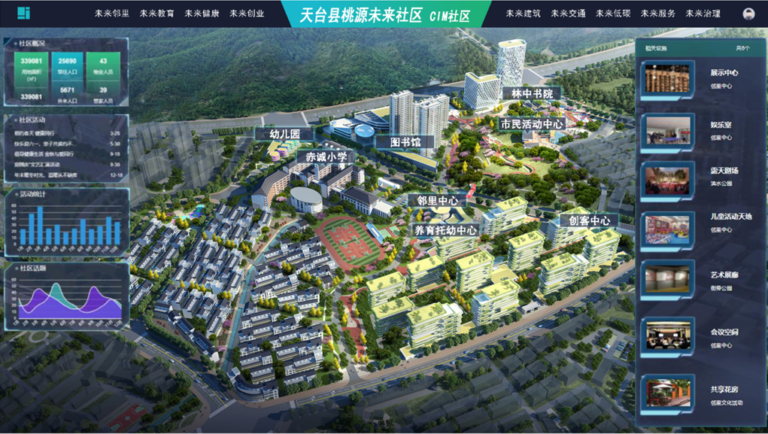Digital technology —— The secret to sustainable community management
Introduction
The community is the foundation of the city and the basic unit of production activities for urban residents. If we compare the family to the cells on which the operation of society depends, then the community in which countless families live is an important organ composed of individual cells. As the process of urbanisation accelerates, community operations and management face increasing challenges. Traditional community management methods often rely on manual labour, which is inefficient, slow to respond and unbalanced in terms of information flow and resource allocation. Moreover, with the diversification of residents’ needs, how to provide personalised and intelligent services has become an urgent issue for community management. As a cellular unit of urban renewal and social governance, communities are of great significance to urban development if they can achieve self-operation and management.
Advantages of digital technology in community operations management

Figure1-Digital application for community(Jianan Liu,2023)
Assist managers in decision-making:Digital technology can help community managers make better decisions through data-driven analysis, such as allocation of community resources and optimisation of maintenance schedules.
Automate processes:Digital technology can automate tedious daily management tasks, such as online repair reporting, lease management, and community activity scheduling, reducing the burden on human labour.
Optimising the resident experience: digital technology can provide personalised services according to residents’ needs, increasing their satisfaction and engagement.
Issues arising from community operations in European countries
Bureaucracy is considered to be the only barrier when it comes to community governance. It exists between the different agencies responsible for each type of public infrastructure, as each is independent. Despite the many efforts made by the government to promote community sustainability, policy support is still insufficient at the specific community level. The Governments fail to integrate the various agencies at the management level and the number of stakeholders creates a duplication of roles in the planning process and highlights the lack of clear leadership(Dixon, T. 2007)
At the same time, the sustainable operation of communities does not depend only on governments and managers, but also on the active participation of community residents. However, many community residents lack community participation awareness and behaviour. This lack of participation by community members makes it difficult to actually put community operation and maintenance measures in place.(Leach, M., Mearns, R. and Scoones, I. 1997)
Digital Management in Chinese Communities
In the context of the information era, Chinese community management is seeking greater refinement and precision, and community managers need to be more up-to-date with the various dynamics of their communities. Thanks to the unique political system, Chinese communities have unique experiences and insights in community operation and governance, and through three dimensions (community management system, community residents’ participation, and digital lean management platform), communities can achieve sustainable operation.
Community management system
Through the reform of the comprehensive community governance system, the powers and functions of various community departments have been clarified and management efficiency optimised.
Attracting the participation of all social parties in community affairs and realising the diversification of community affairs.
Figure2-Digital Management Diagram(Jianan Liu,2023)
Community residents’ participation
Actively guide and encourage residents to participate in the discussion and decision-making of community affairs, and establish community centres and community living rooms as platforms for residents‘ self-governance in the community, so as to enhance residents’ sense of community identity and belonging.
Build community social organisations and volunteer teams for service, public welfare and mutual assistance.
Digital lean management platform
Use digital technology to build a digital platform in the community centre, upward access to the city management platform, downward connection to the community’s basic data, in the digital platform, managers can real-time understanding of the community of the existence of a variety of problems and situations, such as community safety hazards, community emergency assistance, residents’ opinions, the state of the community facilities and so on.
Figure3-Digital lean management platform(Jianan Liu,2023)
Potential risks of digital administration
While digital technologies can increase the transparency and efficiency of administrative processes, they also expose the risk of over-reliance on technology and data standardisation. It has been suggested that while smart sensors offer new tools and perspectives for local governments, their real potential lies in balancing the introduction of technology with human expertise and experience to promote more humane and sustainable social governance.(Zhao, Y.2023)
Conclusion
With the integration of digital technology in community management, relying on the basic community database can help managers make quicker and more accurate responses. At the same time, it also allows residents to enjoy more convenient community services, so that residents are more willing to participate in community affairs management, cohesion of community identity and sense of belonging. The decline of the community, which is a problem that many European communities need to solve, of course, digital technology can not avoid the collection and use of personal information, to ensure the security of personal privacy is also a huge challenge.
Reference
- Dixon, T. (2007). The Property Development Industry and Sustainable Urban Brownfield Regeneration in England: An Analysis of Case Studies in Thames Gateway and Greater Manchester. Urban Studies, 44(12), pp.2379–2400. doi:https://doi.org/10.1080/00420980701540887.
- Leach, M., Mearns, R. and Scoones, I. (1997). Challenges to Community-Based Sustainable Development: Dynamics, Entitlements, Institutions. IDS Bulletin, 28(4), pp.4–14. doi:https://doi.org/10.1111/j.1759-5436.1997.mp28004002.x.
- Meegan, R. and Mitchell, A. (2001). ‘It’s Not Community Round Here, It’s Neighbourhood’ : Neighbourhood Change and Cohesion in Urban Regeneration Policies. Urban Studies, 38(12), pp.2167–2194. doi:https://doi.org/10.1080/00420980120087117.
- Zhao, Y. (2023). Digital governance with smart sensors: exploring grid administration in Zhejiang’s ‘Future Community’. Journal of Computer-Mediated Communication, 28(5). doi:https://doi.org/10.1093/jcmc/zmad016.


